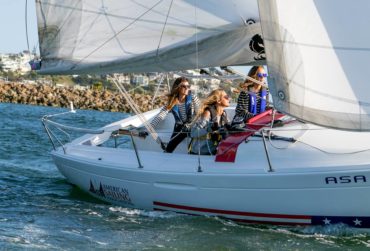 The U.S. Coast Guard’s most recent recreational boating report (pdf) counted 4,291 accidents that involved 658 deaths, 2,629 injuries and approximately $46 million of damage to property as a result of recreational boating accidents.
The U.S. Coast Guard’s most recent recreational boating report (pdf) counted 4,291 accidents that involved 658 deaths, 2,629 injuries and approximately $46 million of damage to property as a result of recreational boating accidents.
Sadly, only 14 percent of the boat operators in fatal accidents had formal safety training, and 81 percent had no training at all. Moreover, in drowning deaths where life jacket usage was known, 84.5 percent of the drowning victims weren’t wearing a life jacket.
With warmer weather and longer days ahead, boating enthusiasts will be flocking to local waterways to enjoy a day, weekend or longer on the water. It’s important to ensure you’re enjoying your excursion safely.
The American Sailing Association has defined an extensive list of safety essentials that every boater should take on the water. If you’re planning to go boating this year, please review the following guidelines and make sure to have the proper safety equipment.
Probably the most important item is the PFD, personal flotation device (“life jacket”). There are styles and types of PFDs appropriate and comfortable for all water activities — some as small and easy to wear as a fanny pack.
In ASA sailing classes, everyone on board wears a PFD at all times. Most race organizations also have the same rule. Remember: It only works if you wear it.
USCG Minimum Legal Safety Requirements
Here is the list of items that the U.S. Coast Guard requires on board:
Personal flotation device (PFD): You must have one PFD, or life jacket, for each passenger, plus one throwable for boats over 16 feet long.
Visual and sound signals: All vessels should have the ability to make a sound signal, such as a compressed air horn. Also, you’ll need equipment to create a day/night visual distress signal, such as a flare that can be seen at any time of day.
Navigation lights: If you plan to operate your vessel at night or in times of limited visibility (such as in fog), your vessel must have the appropriate running lights for its size.
Fire extinguishers: How many and what type varies based on the size of your boat and whether it has a fixed engine-room extinguisher system, so double-check the requirements.
Bear in mind that this is the minimum requirement, not an exhaustive list of safety items. The American Sailing Association recommends that in addition to the above list, you consider keeping additional safety equipment on board.
The following are recommended additional safety items, as taught in ASA sailing classes:
Navigation charts and equipment: Should you ever need to call for help, you’ll want to be able to know where you are and let others know as well. Always make sure to bring a compass.
West Marine VHF Radio: Communication devices like the West Marine VHF75 Radio are a must-have for boating enthusiasts. The floating handheld radio features a power boost key for instant 6-watt transmissions, glow-in-the-dark seals, a large and easy-to-read display and instant access to Channel 16 or Channel 9. It also has access to all NOAA weather channels so you can listen to current weather broadcasts for valuable information, alerts and hazard warnings.
Soft wood plugs: Boats sometimes spring a leak, so keeping various sizes of tapered soft-wood plugs on board can stop unexpected leaks or defective through-hull fittings.
Bilge pump: Think a man with a bucket is the best bilge pump in a sinking boat? Think again. Manual and automatic bilge pumps can dump water out at a much faster rate and are far less exhausting.
Anchor: If the weather gets windy or your engine fails, an anchor provides a safe way to stop your boat from drifting into dangerous waters.
First-aid kit: Along with the basics, such as bandages, antibiotic cream and gauze, make sure to include sunscreen and seasickness remedies.
Tool kit and flashlight: A small tool kit will come in handy for small repairs required at sea. A flashlight can illuminate sails and help you find your way around your boat during a night on the water.
Safety harnesses: You never know when you could hit bad weather or rocky water at night. Please have one for each person on your vessel to keep your passengers from being lost at sea.
Life buoys and a buoyant heaving line: On the chance that someone does fall overboard, life buoys and a buoyant heaving line can help you retrieve them quickly and safely.
Life raft or dinghy: Should your vessel capsize, a life raft will keep everyone afloat until help arrives. Make sure you keep one large enough to carry everyone on board.
Along with these items, the American Sailing Association recommends boaters take a safety course at one of its 350 professionally accredited sailing schools.
The American Sailing Association offers several safety equipment options, such as a top-tier Bluestorm automatic inflatable vest and an electronic flare. To see what’s available, visit store.asa.com.
Remember, for greater detail and assurance that you are meeting the USCG safety standards, visit www.uscgboating.org/images/420.PDF.
























